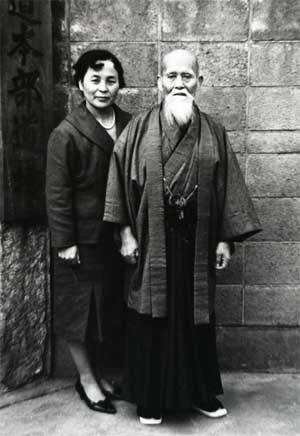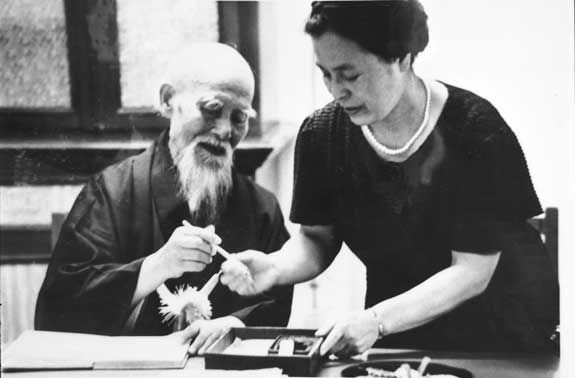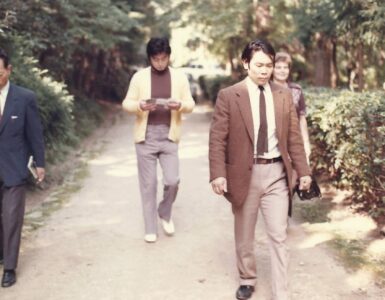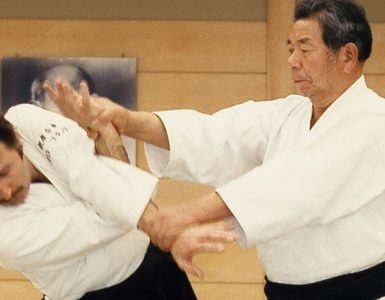“During the last 15 years of his life, Morihei brushed hundreds of
calligraphies, many for his students to display in their aikido schools.”
Relatively late in his life, Morihei Ueshiba enthusiastically took up the art of calligraphy. The impetus for this was his long association with Seiseki Abe of Osaka, one of his devoted students. In addition to his passion for aikido, Abe Sensei also happened to be a renowned calligrapher. Beginning in the mid-1950s, Abe Sensei would give private lessons to Morihei when the Aikido Founder stay at his home in Osaka to teach aikido.
During the last 15 years of his life, Morihei brushed hundreds of calligraphies, many for his students to display in their aikido schools. Abe Sensei wrote this about Morihei’s calligraphy:
Ueshiba Sensei’s spirit resides in his calligraphy not in the forms or shapes of the characters, but in their resonance and light. Similarly, that spirit resides in aikido not in the techniques you can see with your eyes, but in those you cannot.
This photo shows O-Sensei preparing to brush some Japanese characters into a book as Fukiko Sunadomari assists with his brush. Fukiko Sensei was the elder sister of the late Kanshu Sunadomari, a famous aikido teacher of Kumamoto, Kyushu. Her elder half-brother was Kanemoto Sunadomari, the man who wrote the first biography of Morihei, published in 1969.
Fukiko Sensei was a long-time confidante of the Founder and lived for many years in O-Sensei’s Wakamatsu Dojo in Shinjuku with his family and the live-in uchideshi. She also served as the “Fujin Bucho” (director of the women’s section) at the Aikikai for many years.
Fukiko Sensei was often called upon to travel with O-Sensei on his frequent trips to the Kansai area where he frequently taught aikido while visiting long-time students and friends. Many unpublished photos from her personal collection survive, including our photo today.
Of particular interest was a series of trips in the mid-1960s where she accompanied Morihei to gather materials for her brother Kanemoto’s biography of the Founder. She also interviewed a number of old-timers, including Omoto church members who knew Morihei earlier in his career. These interviews with Morihei and the others were recorded on audio tapes that are preserved in Aikido Journal’s archives.

Morihei Ueshiba in front of old Aikikai
I knew Fukiko Sunadomari very well. Our association began in 1984 and continued through the end of 1996. She loved to come visit the Aiki News office in Tokyo, and we spent hours talking about aikido, Morihei, and the Omoto religion. I have many hours of recordings of our talks, one of which is being transcribed now.
Fukiko Sensei knew a great deal about the Founder’s public and private life due to her living in the Hombu Dojo and role as an assistant to Morihei. Fukiko Sensei was also a devout Omoto believer and would frequently stress the importance of Morihei’s involvement with the church and Onisaburo Deguchi as an important factor in O-Sensei’s spiritual growth.
She was an outspoken person and distanced herself from the Ueshiba family following Morihei’s death. As such, her comments and recollections are not always suitable for publication, and we have long refrained from releasing transcripts of these recordings, even in edited form. Given time and resources, we hope to remedy this situation because Fukiko Sensei’s testimony is very important to a deep understanding of Morihei’s history, character, and art.













Very interesting… thanks.
Stanley, I hope that you will find the time to reveal some of the more controversial viewpoints that you have gathered through interviews over the years. You ocassionally hint at these, and I would like the full history of the founder and the development of Aikido… warts and all.
Thanks for all you do!
These areas are very sensitive, otherwise, I would have already published certain documents and testimonies. Even though many decades separate us from some of the events in question, the sensitivities of key individuals are a matter of concern. This is something I have wrestled with for a long time, and still don’t have a good solution. I felt very hesitant to publish Koichi Tohei Sensei’s letter of resignation, for example. We’ll see how things play out.
Sensei Pranin,
Yes, these areas are very sensitive …. BUT, I feel very important to the Aikido world. For all that’s worth.
Thank you for all you do.
Love and Light
Scott
Hello Stanley,
Fully agree that great care and restraint must be excercised in sharing extremely intimate, personal and private information about personalities and famous mentors of the past with the public at large. Communication amongst proven peers for the purpose of getting facts right, of sharing and addressing concerns of etiquette and good taste, and of making extra sure of certain matters of provenance, is a different matter entirely. On these, the public must dutifully wait its turn. After all, there is so much to sift through, and the legacies and memories of those researched deserve the highest levels of care, thorough examination of all available facts, and the very difficult task of translating first hand accounts by those who knew the Founder personally. It must take the time, patience and thoroughness it deserves. You, Stanley Pranin, are imminently qualified for such a herculean and unenviable task.
Thank you for your uncompromising standards of ethical treatment of the legacy of the Founder.
Hi Stanley,
May we ask what personal criteria you apply for choosing to release document, testimonies or information ? I think for example of a moratory of several years after the interviewed person’s passing. Did you ask people if they had wishes about how their information be used after you received it ? Or do you play it by ear ?
I remember that in Paris last year, you insisted that the chief obstacle to the release of information to the general public was more practical than ethical : translation work, organisation of archives, etc.
In any case, thank you for all the great work.
I think what has happened, Ludwig, with time is that most of the principals have passed on. In some cases, it becomes a little more comfortable to release documents where one hesistated before. Each case is very different and depends upon the personalities involved. By the way, thank you again for your fantastic assistance last year in Paris! It was a wonderful experience for me. It looks like I’ll be in Belgium next March.
– – – – surely time to publish SOME part of the material???
– – – it would be wonderful to hear more about the Omoto-Kyo dojos
of the late twenties and early thirties – especially any reminiscences of
training – – – personally, I’d also be interested to hear more about the
Jinrui Aizenkai down the years – – –